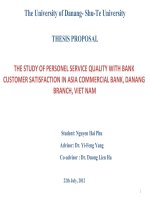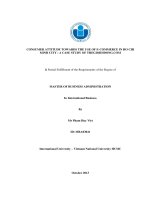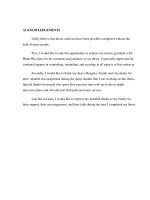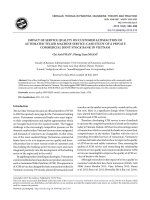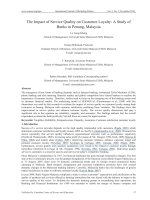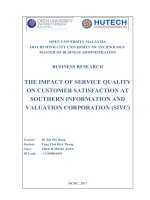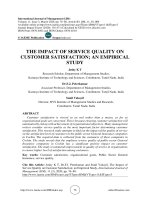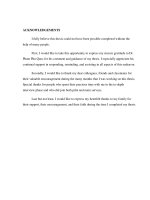The impact of service quality on grabs customer satisfaction in ho chi minh city an empirical study in the covid 19 epidemic
Bạn đang xem bản rút gọn của tài liệu. Xem và tải ngay bản đầy đủ của tài liệu tại đây (1.22 MB, 106 trang )
MINISTRY OF EDUCATION AND TRAINING THE STATE BANK OF VIETNAM
BANKING UNIVERSITY OF HO CHI MINH CITY
TRAN DINH THUY LINH
THE IMPACT OF SERVICE QUALITY ON GRAB’S
CUSTOMER SATISFACTION: AN EMPIRICAL
STUDY IN THE COVID 19 EPIDEMIC
BACHELOR THESIS
FACULTY OF BUSINESS ADMINISTRATION
SUBJECT CODE: 7340101
HO CHI MINH CITY, 2021
MINISTRY OF EDUCATION AND TRAINING THE STATE BANK OF VIETNAM
BANKING UNIVERSITY OF HO CHI MINH CITY
TRAN DINH THUY LINH
THE IMPACT OF SERVICE QUALITY ON GRAB’S
CUSTOMER SATISFACTION: AN EMPIRICAL
STUDY IN THE COVID 19 EPIDEMIC.
BACHELOR THESIS
FACULTY OF BUSINESS ADMINISTRATION
SUBJECT CODE: 7340101
SUPERVISOR: Ph.D. NGUYEN VAN THUY
HO CHI MINH CITY, 2021
DECLARATION
I declare that this final study is entirely my composition. All references made
to works of other persons have been duly acknowledged. The figures in this thesis are
taken from sources that are published.
I am responsible for my thesis.
Signature
Tran Dinh Thuy Linh
ACKNOWLEDGE
I am willing to take this opportunity to acknowledge several individuals who
have helped me to complete my thesis.
First of all, I would like to give my endless thanks and gratefulness to my
supervisor, Ph.D. Nguyen Van Thuy. His kindly and continuous advice went through
the process of completion of my thesis. His encouragement and comments had
significantly enriched and improved my work. Without his motivation and
instruction, the thesis would have been impossible effectively.
Secondly, I want to thank my family for their endless love, care and have most
assistance and motivation for me for my whole life.
Next, my deepest thanks come to all of my friends who always support me
when I study at university. I am thankful for the times, and they have listened to me,
advised me, and even comforted me. They are kindly helped, cared for, and motivated
gave me strength, and lifted me all the trouble for the rest of my life.
TABLE OF CONTENT
CHAPTER 1. INTRODUCTION ............................................................................1
1.1. Problem thesis ..................................................................................................1
1.2. Aims and objective of the research ................................................................3
1.3. Subject and scope of the research ..................................................................4
1.4. Research method .............................................................................................4
1.5. Structure of thesis ............................................................................................4
1.6. Summary ..........................................................................................................5
CHAPTER 2. LITERATURE REVIEW ................................................................6
2.1. The basic concepts ...........................................................................................6
2.1.1. Customer satisfaction .................................................................................6
2.1.2. Service quality ............................................................................................7
2.1.3. The relationship between service quality and customer satisfaction.......10
2.2. Theoretical research ......................................................................................12
2.3. Conceptual model and hypothesis ................................................................17
2.3.1. Hypothesis ................................................................................................17
2.3.2. Research model ........................................................................................20
2.4. Summary ........................................................................................................21
CHAPTER 3. METHODOLOGY .........................................................................22
3.1. Design of research..........................................................................................22
3.1.1. Research process ......................................................................................22
3.1.2. Modify the questionnaires ........................................................................24
3.2. Building the scale ...........................................................................................24
3.2.1. The scale of reliability (RE) .....................................................................25
3.2.2. The scale of responsiveness (RS) .............................................................25
3.2.3. The scale of empathy (EM) ......................................................................26
3.2.4. The scale of tangibles (TA) ......................................................................26
3.2.5. The scale of assurance (AS) .....................................................................27
3.2.6. The scale of price policy (PR) ..................................................................27
3.2.7. The scale of customer satisfaction (CS) ...................................................28
3.3. Sample and data ............................................................................................28
3.3.1. Sample size ...............................................................................................28
3.3.2. Survey questionnaire ................................................................................29
3.3.3. Collecting data .........................................................................................29
3.4. Data analysis ..................................................................................................30
3.4.1. Test reliability by Cronbach's Alpha .......................................................30
3.4.2. Test Validity by Exploratory factor analysis (EFA).................................31
3.4.3. Regression Analysis. ................................................................................32
3.4.4. ANOVA test ..............................................................................................34
3.5. Summary ........................................................................................................34
CHAPTER 4. RESULT AND FINDING ..............................................................35
4.1. Company overview ........................................................................................35
4.1.1. History of Grab Holding Inc. ...................................................................35
4.1.2. About Grab Vietnam ................................................................................36
4.2. Sample description ........................................................................................38
4.3. Reliability test by Cronbach’s Alpha ...........................................................40
4.3.1. Evaluating reliability scale ......................................................................40
4.3.2. Evaluating responsiveness scale ..............................................................41
4.3.3. Evaluating tangibles scale .......................................................................41
4.3.4. Evaluating empathy scale ........................................................................42
4.3.5. Evaluating assurance scale ......................................................................42
4.3.6. Evaluating price policy scale ...................................................................43
4.3.7. Evaluating customer satisfaction scale ....................................................43
4.4. Results of exploratory factor analysis (EFA) ..............................................44
4.4.1. Factors analysis for independent variables .............................................44
4.4.2. Factors analysis for the dependent variable. ...........................................46
4.4.3. Conclusion about exploratory factors analysis. ......................................47
4.5. Correlation analysis.......................................................................................51
4.6. Test of regression analysis ............................................................................52
4.7. Testing of the sample .....................................................................................55
4.7.1. The difference in gender...........................................................................56
4.7.2. The difference in age ................................................................................56
4.7.3. The difference in occupations ..................................................................57
4.7.4. The difference between the frequency ......................................................58
4.7.5. The difference between essential service during COVID-19 ...................59
4.8. Summary ........................................................................................................59
CHAPTER 5. CONCLUSIONS AND IMPLICATIONS ....................................60
5.1. Conclusions ....................................................................................................60
5.2. Implications managements improve customer satisfaction on Grab’s users.
................................................................................................................................61
5.2.1. Grab should highly focus on price policy to enhance customer satisfaction
with its services. .................................................................................................61
5.2.2. Grab should concentrate on assurance for users to enhance customer
satisfaction. ........................................................................................................62
5.2.3. Grab should focus on service competence to enhance its customer
satisfaction. ........................................................................................................63
5.2.4. Grab should consider reliability to enhance customer satisfaction. .......63
5.2.1. Grab should consider responsiveness to enhance customer satisfaction.
............................................................................................................................64
5.3. Contribution of the study ..............................................................................64
5.4. Limitations and future research...................................................................65
5.5. Summary ........................................................................................................65
REFERENCES ........................................................................................................66
APPENDIX 1: QUESTIONNAIRE SURVEY .....................................................71
APPENDIX 2: DATA ANALYSIS RESULT .......................................................77
LIST OF ACRONYMS
Acronyms
Meaning
EFA
Exploratory Factor Analysis
ANOVA
Analysis of Variance
Sig.
Significance level
VIF
Variance Inflation factor
KMO
Kaiser-Mayer-Olkin
RE
Reliability
RS
Responsiveness
TA
Tangibles
EM
Empathy
PR
Price Policy
AS
Assurance
CS
Customer satisfaction
LIST OF FIGURES
Figure 2.1: Research model.......................................................................................20
Figure 3.1: Research process.....................................................................................23
Figure 4.1: Research model after EFA ......................................................................51
LIST OF TABLES
Table 2.1: Previous studies summary .......................................................................14
Table 2.2: Synthesize the hypothesis of the current research ...................................19
Table 3.1: Encode the reliability scale ......................................................................25
Table 3.2: Encode the responsiveness scale ..............................................................25
Table 3.3: Encode the empathy scale ........................................................................26
Table 3.4: Encode the tangibles scale .......................................................................26
Table 3.5: Encode the assurance scale ......................................................................27
Table 3.6: Encode the price policy scale ...................................................................27
Table 3.7: Encode the customer satisfaction scale ....................................................28
Table 4.1: Sample description ...................................................................................38
Table 4.2: The frequency of Grab services ...............................................................39
Table 4.3: Result of the reliability assessment of reliability scale ............................40
Table 4.4: Result of the reliability assessment of responsiveness scale ...................41
Table 4.5: Result of the reliability assessment of tangibles scale .............................41
Table 4.6: Result of the reliability assessment of empathy scale .............................42
Table 4.7: Result of the reliability assessment of assurance scale ............................42
Table 4.8: Result of the reliability assessment of price policy scale ........................43
Table 4.9: Result of the reliability assessment of customer satisfaction scale .........43
Table 4.10: Synthesize Cronbach’s Alpha of each variable .....................................44
Table 4.11: The result of KMO and Bartlett's Test for independent variables .........45
Table 4.12: Eigenvalue and covariance deviations for independent variables .........45
Table 4.13: Result of independent factor analysis with principal varimax rotation .45
Table 4.14: The result of KMO and Bartlett’s Test for the dependent variable .......46
Table 4.15: Eigenvalue and covariance deviations for the dependent variable ........47
Table 4.16: The factor rotation matrix of the dependent variable ............................47
Table 4.17: The Service Competence scale after EFA .............................................48
Table 4.18: The Responsiveness scale after EFA .....................................................48
Table 4.19: The Assurance scale after EFA ..............................................................49
Table 4.20: Synthesize items of each scale after EFA ..............................................49
Table 4.21: Synthesize the new hypothesis after EFA..............................................50
Table 4.22: Pearson Correlation Analysis.................................................................51
Table 4.23: Model Summary.....................................................................................52
Table 4.24: ANOVA Analysis ..................................................................................52
Table 4.25: Result of dependent variables’ linear regression ...................................53
Table 4.26:Synthesize the result of the hypothesis test ............................................55
Table 4.27: One-way ANOVA by gender ................................................................56
Table 4.28: One-way ANOVA by age ......................................................................56
Table 4.29: One-way ANOVA by occupations ........................................................57
Table 4.30: One-way ANOVA by frequency ...........................................................58
Table 4.31: Post Hoc test by frequency ....................................................................58
Table 4.32: One-way ANOVA by advocates and opponents of Grab services ........59
Table 5.1: Descriptive statistics of price policy scale ...............................................61
Table 5.2: Descriptive statistics of assurance scale ..................................................62
Table 5.3: Descriptive statistics by empathy scale ...................................................63
Table 5.4: Descriptive statistics of reliability scale ..................................................64
Table 5.5: Descriptive statistics of responsiveness scale ..........................................64
ABSTRACT
This thesis aims to explore the demographic characteristics and determine
what service quality factors impact customer satisfaction—this study base on the
model SERVPERF by Cronin and Taylor (1992). Quantitative and qualitative
methods were used to collect and analyze the data—the quantitative study was
conducted by group discussion. In the qualitative research, the impact of 6 factors on
customer satisfaction was analyzed using survey questionnaire data collection from
259 respondents using Grab services during the fourth outbreak of COVID 19 in Ho
Chi Minh city. Based on the study result, the determinant factors that impact Grab’s
customer satisfaction in Ho Chi Minh City are assurance, price policy, service
competence, reliability, and responsiveness. The most influential factor is assurance,
and the least impacted factor is responsiveness. From the result of the study, several
research implications have been proposed to improve and enhance Grab customer
satisfaction.
Keywords: reliability, responsiveness, assurance, empathy, tangibles,
customer service, Grab, COVID 19
1
CHAPTER 1. INTRODUCTION
This chapter provided an overview of the current studies, discussing how
service quality impacted customer satisfaction in ride-hailing service. It also
explored and identified factors relevant to the customer satisfaction of Grab users
in Ho Chi Minh city. This chapter includes the research background, research
method, key issues and assumptions of the study, primary purposes, and thesis
plan.
1.1. Problem thesis
Grab is a technology company that provides transportation services and is
located in Singapore. Vietnam is also a country with solid Grab activities. However,
providing taxi services like Uber in Malaysia and Singapore. To match the traffic
situation in Vietnam, Grab has promoted the benefit of moving by motorbike. It can
be said that Grab appears as a new breeze is moving in Southeast Asian countries.
App-based transportation services can compete with the traditional form regarding
security, comfort, and convenience.
Grab is currently experiencing strong growth in 8 countries and 195 cities in
Southeast Asia. This technology car booking mobile application is estimated to have
been used by 90 million devices. More than five million people use it every day—
more than 2 million drivers-account for 95% of the worldwide motorbike taxi market
(Pradhan, 2019). Vietnam has seen a significant increase in smartphone-ordered rides
in the last few years by the emergence of technology companies providing
transportation and commuting services such as Grab and Uber. Besides, in 2018, Uber
sold its Southeast Asian business to Grab by exchanging many shares, up to about 20
or 30%, and officially withdrawing from Southeast Asia, including Vietnam. Until
that, Grab held nearly 80% of the market share in Vietnam while other competitors
only account for a meager 20%. (Nguyễn, 2018)
It appeared in Vietnam in 2014 with the original name GrabTaxi but did not
attract attention. To cater to Vietnamese's demand, GrabBike, a service of GrabTaxi,
2
is a new safe motorbike taxi service with the motto "Cheaper, more convenient"
launched in November 2014 in Ho Chi Minh City, present in Hanoi in May 2015.
According to ABI Research's report on Vietnam's ride-hailing market in the first six
months of 2020, Grab is still the market leader in ride-hailing and completed 62.5
million rides accounting for 74.6% of the market share small donation compared to
73% in the first half of 2019. This market position is firm in a big city such as Hanoi
and especially with Ho Chi Minh City – the economic center in Vietnam with a
population of over 8.6 million people in 2020 – where Grab holds 82% of the market
and becomes the most attractive market not only for the domestic but also the foreign
company.
However, the Coronavirus, which appeared in December 2019 in Wuhan,
China, has challenged the global health system, and the worldwide economy has also
been significantly impacted. Vietnam is no exception. Especially with the 4th
outbreak, which started in late April 2021, the number of Vietnamese infections in
the community recorded 97.370 cases as of July 2021, including Ho Chi Minh city,
the epicenter, witnessed 62.139 instances of the impact of the Delta variant. Ho Chi
Minh City authorities have been imposing measures and directives 15 and 16,
depending on the difficult period of the pandemic. Besides, there has a disparity
between both two of them. Directive 15 requires a suspension to social events, bans
gathering of 20 people or more in one place, and ten people outside workplaces,
schools, and hospitals. Citizens should ensure a minimum distance of two meters in
public areas. The stricter measures are imposed by Directive 16, which does not allow
gatherings of more than two people in public. Urbanites only leave home for
emergencies, buying essential goods and services such as food and medicine (Viết &
Tạ, 2021). During the citywide social distancing period, Ho Chi Minh city authorities
required motorbike taxi service, both traditional and app-based, for passenger
transport, food delivery will suspend. In contrast, services for goods delivery like
GrabMart, GrabExpress are still available to ensure food supply for dwellers (Grab,
2021).
3
Customer satisfaction is an individual perception when they feel pleasure or
despaired comparing with the received product or service and their expectations
(Kotler and Keller, 2012). Pham & Nguyen (2020) conducted the related research on
both Ha Noi and Ho Chi Minh City; however, it only focuses on GrabBike and
GrabCar services, while Grab is identifying them as a super app model, which
included more functions such as delivery, bills, and phone payments, and booking,
similar with Nguyen-Phuoc et al. (2020). Even though Grab gains a big gap with its
competitors, catering to customers satisfaction should take an indispensable role to
maintain its market position, and it is no doubt that there have limited researches for
Grab, especially with Ho Chi Minh city, where Grab accounts for the most market
share in Vietnam. From the reality perspective, in the scenario of Covid 19, this thesis
decided to choose the topic "The impact of service quality on Grab's customer
satisfaction in Ho Chi Minh City: An Empirical Study in the Covid 19 epidemic."
1.2. Aims and objective of the research
The aims and objectives are to identify service quality factors that impact on
customer satisfaction of Grab's users. Therefore, the thesis aims to analyze the
following purposes:
- To verify and explore service quality factors impacting on customer
satisfaction of users using Grab
- To evaluate service quality factors affecting customer satisfaction
- To propose implications to enhance the satisfaction of Grab's users.
Based on aims and objectives, the thesis gives three questions below:
- Which are the factors of service quality affecting customer satisfaction on
Grab's users?
- How do service quality factors affect customer satisfaction on Grab's users?
4
- What are the implications for enhancing customer satisfaction of Grab's
users?
1.3. Subject and scope of the research
The subject of the study analyzes factors of service quality affecting customer
satisfaction on Grab's users.
The scope of the study includes users who have used Grab in Ho Chi Minh
City, Vietnam.
Time of the research: Carry out from 07/2021 to 09/2021
1.4. Research method
The qualitative method aims to determine this research's problem based on
related research about customer satisfaction to propose a model. Besides, this
research base on the literature review, the research process, and the scale of factors
to suggest customer satisfaction. After that, a pilot version of the questionnaire will
be conducted by random people who have used Grab services from 18 to 30 years
old.
The quantitative method includes survey questionnaires for customers who
used Grab services in Ho Chi Minh City to collect information. The data will be
analyzed by SPSS Statistics 20 to describe the sample and eliminate inconsistently
observed variables in a factor by Cronbach's Alpha. Besides, this research uses EFA
to explore elements and evaluate the internal reliability of a scale. Regression aims to
examine factors that contribute to the change of independent variables.
1.5. Structure of thesis
The study is structured in 5 chapters as follows:
Chapter 1: Introduction
This chapter will provide the broad research background, aims, and objectives
of the research, the scope of the study, and the research method.
5
Chapter 2: Literature review
This chapter will focus on the theories and research findings of the impact of
brand equity on consumer purchase products. Besides, this chapter also provided the
theoretical framework and concepts related to service quality, customer satisfaction.
Chapter 3: Research methodology
This chapter will present the detail of the current study's methodological
research framework, including research design, methodology, data sources,
qualitative analysis, and quantitative study.
Chapter 4: Result and Finding
This chapter will analyze and discuss the data collected by the customers who
used the Grab service in Ho Chi Minh City.
Chapter 5: Conclusion and implications
This chapter will discuss the essential findings and fundamental problems
relevant to factors affecting the customer satisfaction of Grab's users in Ho Chi Minh.
It has also provided the limitation of the study and recommendations for future
research.
1.6. Summary
This chapter provided an overview of the current study. It introduced the
research background, context, and structure of the present study. Later, it described
the key issues that have led to the current research and identified the primary purpose,
which is to investigate what drives the satisfaction of Grab users in Ho Chi Minh city.
The next chapter will look at theoretical perspectives of customer satisfaction.
6
CHAPTER 2. LITERATURE REVIEW
2.1. The basic concepts
2.1.1. Customer satisfaction
There are many different definitions of customer satisfaction, and there is quite
a bit of debate about this. Some researchers think that there is a disparity in
satisfaction between customer expectations and the actual perception received.
Customer satisfaction is a customer's overall attitude towards a service
provider or an emotional response to the difference between what the customer
expects before and what they receive to fulfill their needs, goals, or desires.
(Hansemark & Albinsson, 2004). According to Kotler and Armstrong (2012),
customer satisfaction is the level of a person's sensory state resulting from comparing
the results obtained from consuming a product/service with their expectations. The
range of satisfaction depends on the difference between the received results and the
expectations. If the expectation is higher than the actual results, the customer is
dissatisfied, and if the actual results match the expectations, the customer is satisfied.
Moreover, if the perceived quality overcomes the expectations, the customer
will show delighted. The power of delighted customers can have a positive effect on
the company's performance. Pleased customers are loyal customers and a suitable
marketing partnership by sharing their good experiences with other people
surrounding them. Expectations are viewed as human expectations. It originates from
personal needs, previous experiences, and external information such as advertising,
news, word of mouth from friends, family. Individual needs are formed from the
perception that people want to be satisfied with communication needs and food.
In addition, previous experience also has a significant influence on
expectations. The knowledge gained is due to learning and experience; the more
experienced, the higher the expectation. Finally, outside information also raises
expectations. Satisfaction is the consumer's response to estimating the difference
7
between previous expectations and the product's actual performances the ultimate
acceptance of using it (Tse & Wilton, 1988). Alternatively, satisfaction is the
consumer's response to the fulfillment of wants (Oliver, 2010).
Customer satisfaction includes two components (Parasuraman, Zeithaml, &
Berry, 1988; Carman, 1990). One is the satisfaction achieved when purchasing
quality goods or services at a reasonable price. The second is the relationship gained
from the business transaction process accumulated over time, such as trust in service
providers, the professional ability of employees, and the service attitude of customers.
According to Zeithaml and Bitner (2000), service quality and customer
satisfaction are two concepts; while service quality focuses specifically on service
components, the customer's satisfaction level is a general concept.
There is still no consensus among studies on the concepts, but most researchers
believe that there is a connection between service quality and customer satisfaction
(Cronin & Taylor, 1992; Spreng et al., 1996; Indra & Ibrahim, 2017; Bismo et al.,
2018; Nguyen et al., 2020; and Hayder, 2020). However, many studies have not
focused on examining the explanatory level of service quality components for
customer satisfaction, especially in each specific service industry. Therefore, a
problem is needed to study more about the relationship between the factors of service
quality and the level of customer satisfaction in particular areas.
2.1.2. Service quality
Since the 1930s, quality in the manufacturing sector has been identified as one
of the competitive factors, while service quality has only developed in recent decades.
To define, evaluate as well as manage quality in the service field comes from the
manufacturing sector the International Organization for Standardization (ISO)
definition has been given as follows: "Quality is the ability of a set of characteristics
of a process, system, and product to meet the requirements of the customers and
stakeholders." Thus, from the above definition, if customers do not accept a product
8
for some reason, it is considered poor quality, even though the technological level of
manufacturing that product has a good quality and modern. While measuring the
quality of products, there are many advantages compared to service quality. Buying
goods, the customer can observe the tangible product before deciding, such as style,
hardness, label, package. At the same time, service quality has limited concrete
evidence to judge, like physical facilities, equipment, and personnel (Parasuraman,
Zeithaml, & Berry, 1985). Service quality is a measure to determine how well the
service matches and conforms with customer expectations consistently. Gronroons
(1982) conducted a model that presented consumers comparing the perception of
received service with their expectations.
With different characteristics compared to the above tangible products,
services have caused customers to evaluate before, during, and after consumption.
Moreover, due to the intangible nature of the service, the service provider also faces
difficulties in knowing the customer's feelings and evaluate the service quality. While
consuming a service, service quality is reflected in the customer and the service
provider (Svensson, 2002). Parasuraman et al. (1985, 1988, 1991) discovered this
concept among researchers on service quality after conducting many studies.
According to Parasuraman et al. (1985), service quality is the difference between
consumers' expectations about service and their perception of its outcome.
2.1.2.1. Functional and technical service quality model
According to Gronroos (1984), service quality is assessed by comparing the
value that customers expect before using the service and the value that customers
receive when using the service.
Research problem: How do technical quality and functional quality affect
service delivery and customer perception of service? What are those factors?
Gronroos offers three criteria to measure service quality: technical quality,
functional quality, and image quality.
9
(1) Technical quality describes what the service is provided with and what
quality the customer receives.
(2) Functional quality describes how the service is delivered, or the customer
receives the technical quality outcome.
(3) Image is a critical factor, built mainly on the service's technical and
functional quality and other factors such as tradition, word of mouth, pricing policy,
PR).
2.1.2.2. Service Quality Gap Analysis model (SERVQUAL)
According to Parasuraman et al. (1985), service quality is "the degree of
difference between consumers' expectations about the service and their perception of
the service's results." These studies have developed a measurement tool consisting of
22 observed variables (SERVQUAL), widely used in measuring service quality. This
scale provides researchers with the ability to measure the gap between service
performance and customer expectations. The service quality gap model is as follows:
–
GAP 1 is the gap between the customer's real expectations and the tourism
service manager's perception. If this gap is large, it means that tourism managers do
not know what customers expect. So understanding what customers expect is the first
and most crucial step in delivering quality service.
–
GAP 2 is the gap between the service manager's perception of what customers
expect and the conversion of those perceptions into their service quality standards.
–
GAP 3 is between the service quality standards established by the tourism
service enterprise and the quality of the primary tourism services provided (that is,
the performance of service delivery by defined standards or not).
–
GAP 4 is the gap between the quality of the service provided and the
information, advertising, or promises that a travel service offers to customers; it
shows how the service manager can make service promises to them or not.
10
–
GAP 5 is the gap between the expected service and the received (perceived)
service. It seems that the high and low ratings for service quality depend on the
customer's perception of the actual service results and the customer's expectations
about that service.
Parasuraman suggested that at the point where the GAP 5 is zero, service quality will
be perfect.
2.1.2.3. The
performance-based
measure
of
service
quality
(SERVPERF)
Cronin and Taylor (1992) studied the concepts and methods of measuring
service quality and the relationship with customer satisfaction and purchase intention,
concluding that perceived factors are a better predictor of service quality.
According to the SERVPERF model of Cronin and Taylor, measuring service
quality is considered a convenient and straightforward method in measuring service
quality based on measurement through the results of service quality. According to the
SERVQUAL model of Parasuraman et al. (1985), Cronin and Taylor argue that the
analytical framework easily confuses customer satisfaction and attitude. These
authors argue that service quality can be defined as “similar to an attitude” and that
service. Accordingly, service quality is assessed only through customers' perception
without evaluating service quality in customer expectations, without weighing each
quality component.
2.1.3. The relationship between service quality and customer satisfaction.
There is empirical evidence that service quality is a causal antecedent of
customer satisfaction (Cronin and Taylor, 1992; Woodside et al., 1989). However,
few empirical studies demonstrate the importance of service quality measurements in
determining customer satisfaction (Fisk et al., 1993; Levesque and McDougall,
1996). Previous studies have suggested that service quality directly and significantly
affects satisfaction (Caruana et al., 2000; Baker and Crompton, 2000). Since
perceived service quality reflects the difference between customer expectations and
11
actual performance, lower expectations or higher perceived performance are more
likely to improve perceived satisfaction. Satisfaction is a direct precursor to
behavioral intention (Cronin et al., 2000; Petrick and Backman, 2002; Dodds, 1991).
However, research on customer satisfaction has shifted towards the feedback
model, in which brands and products satisfaction are considered as a result of two
cognitive variables: pre-purchase expectations and not acknowledged (Churchill and
Surprenant, 1982; Peter and Olson, 1996). According to Peter Olson (1996),
"expectations are beliefs about the expected performance of a product; does not admit
to the difference between pre-purchase expectations and post-purchase perceptions."
In a previous study, Churchill and Surprenant (1982) reported that feedback
positively affects satisfaction. That is, when subjects perceived the product to perform
better than expected, they were more satisfied (Churchill and Surprenant, 1982). The
empirical result supported the notion that satisfaction is due to expectations and
requires considerable perceived effort by customers (Bearden and Teel, 1983;
Moutinho and Goode, 1995; Cadotte et al., 1987). Levesque and McDougall (1996)
found that core service provider performance and service relationship metrics are
essential drivers of customer satisfaction in the retail banking sector in the United
States. However, in a non-Western context, the link between the core and measure
relationship of service and customer satisfaction has not been empirically established.
Enterprises often assume that service quality and customer satisfaction are the
same, interchangeable. Many studies show that service quality and customer
satisfaction are two distinguishing concepts (Zeithaml & Bitner, 2000) and have
tested and proven the relationship between service quality and satisfaction (Cronin &
Taylor 1992; Spreng & Mackoy 1996). However, few studies have focused on trying
the explanatory level of service quality components for customer satisfaction,
especially in specific service industries (Lassar et al., 2000). Zeithaml & Bitner
(2000) consider service quality as a factor affecting customer satisfaction.
